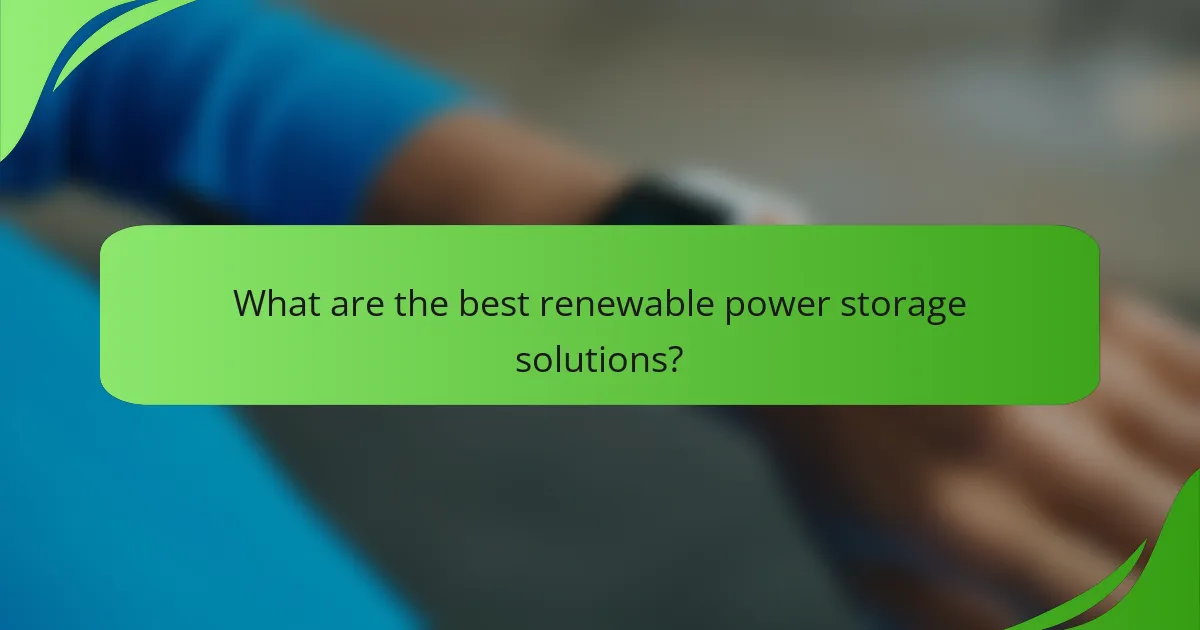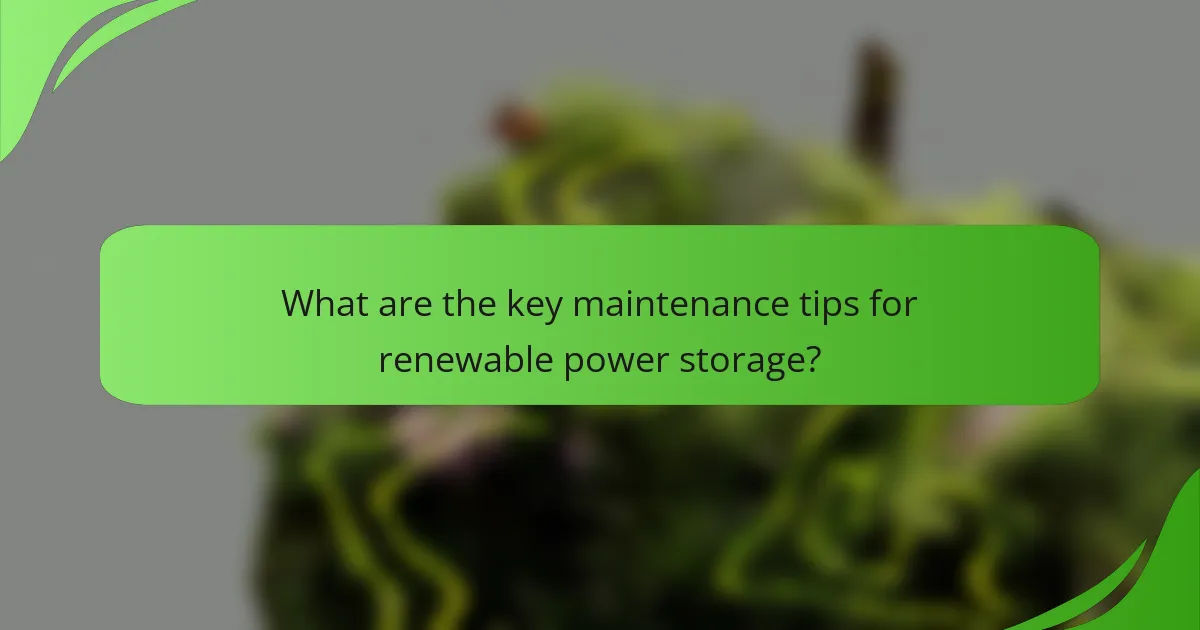Effective maintenance of renewable power storage solutions is crucial for maximizing their performance and lifespan. Regular inspections and maintenance practices, such as cleaning and monitoring environmental conditions, can prevent issues and enhance efficiency. By following best practices tailored to specific storage technologies, users can ensure their systems operate at peak performance.

What are the best renewable power storage solutions?
The best renewable power storage solutions include lithium-ion batteries, flow batteries, compressed air energy storage, pumped hydro storage, and solid-state batteries. Each solution has unique characteristics, advantages, and considerations that make them suitable for different applications in renewable energy systems.
Lithium-ion batteries
Lithium-ion batteries are widely used for renewable energy storage due to their high energy density and efficiency. They are commonly found in residential solar systems and electric vehicles, providing quick discharge rates and relatively low maintenance needs.
When considering lithium-ion batteries, it’s important to monitor their temperature and charge cycles to prolong lifespan. Regularly checking for signs of wear or degradation can help prevent performance issues.
Flow batteries
Flow batteries utilize two electrolyte solutions stored in external tanks, allowing for scalable energy storage. They are particularly advantageous for large-scale applications, such as grid storage, due to their long cycle life and ability to discharge energy over extended periods.
Maintenance involves monitoring the electrolyte levels and ensuring proper pump functionality. Flow batteries are less prone to overheating, making them a safer option for larger installations.
Compressed air energy storage
Compressed air energy storage (CAES) systems store energy by compressing air in underground caverns or tanks. When energy is needed, the compressed air is heated and expanded to drive turbines, generating electricity.
CAES systems require significant infrastructure and are best suited for large-scale applications. Regular maintenance includes checking the integrity of storage facilities and monitoring pressure levels to ensure efficiency and safety.
Pumped hydro storage
Pumped hydro storage is a mature technology that uses two water reservoirs at different elevations. During low demand, excess energy pumps water to the upper reservoir, and during high demand, the water is released to generate electricity.
This method is highly efficient and can provide large-scale storage. However, it requires suitable geographical locations and significant initial investment. Regular inspections of dam integrity and water quality are essential for safe operation.
Solid-state batteries
Solid-state batteries represent an emerging technology that uses solid electrolytes instead of liquid ones, offering higher energy densities and improved safety. They are still in the development phase but show promise for future renewable energy applications.
While solid-state batteries may not yet be widely available, monitoring advancements in this technology can provide insights into future storage solutions. Considerations include potential costs and the need for new manufacturing processes as the technology matures.

How often should renewable power storage systems be maintained?
Renewable power storage systems should be maintained regularly to ensure optimal performance and longevity. Maintenance frequency typically includes monthly inspections, quarterly performance checks, and annual deep maintenance.
Monthly inspections
Monthly inspections are crucial for identifying minor issues before they escalate. During these inspections, check for any visible signs of wear, loose connections, and ensure that the system is operating within expected parameters.
Common tasks include cleaning terminals, checking fluid levels in batteries, and verifying that all safety systems are functional. Keeping a checklist can help streamline this process and ensure no steps are overlooked.
Quarterly performance checks
Quarterly performance checks involve a more in-depth analysis of the system’s efficiency and output. This includes monitoring energy storage levels, discharge rates, and overall system performance against benchmarks.
Consider running diagnostic tests to assess battery health and system efficiency. If performance dips significantly, it may indicate the need for repairs or component replacements.
Annual deep maintenance
Annual deep maintenance is essential for comprehensive system health. This process typically includes replacing worn components, conducting thorough cleaning, and performing detailed inspections of all system parts.
During this maintenance, consider engaging a professional service to ensure compliance with local regulations and standards. This can help avoid costly repairs and extend the lifespan of your renewable power storage system.

What are the key maintenance tips for renewable power storage?
Key maintenance tips for renewable power storage include regular cleaning, monitoring environmental conditions, checking for corrosion, and performing battery balancing procedures. These practices help ensure optimal performance and longevity of storage systems.
Regular cleaning of components
Regular cleaning of storage components is crucial for maintaining efficiency. Dust and debris can accumulate on solar panels, inverters, and batteries, hindering performance. Schedule cleaning at least twice a year, or more frequently in dusty environments.
Use a soft cloth or brush for delicate components and avoid harsh chemicals. For solar panels, a gentle rinse with water can suffice, while batteries may require specific cleaning solutions depending on the type.
Monitoring temperature and humidity
Temperature and humidity levels significantly impact the performance and lifespan of renewable power storage systems. Ideally, batteries should be kept in a cool, dry environment, with temperatures ranging from 20°C to 25°C (68°F to 77°F).
Install temperature and humidity sensors to monitor conditions continuously. If levels exceed recommended ranges, consider using climate control solutions, such as ventilation or dehumidifiers, to protect your equipment.
Checking for corrosion
Corrosion can occur on battery terminals and other metal components, leading to poor connections and reduced efficiency. Regularly inspect these areas for signs of rust or corrosion, especially in humid climates.
If corrosion is found, clean the affected areas with a mixture of baking soda and water, and ensure connections are tight. Applying a protective coating can help prevent future corrosion.
Battery balancing procedures
Battery balancing is essential for maximizing the performance and lifespan of battery storage systems. This process ensures that all cells within a battery pack are charged and discharged evenly, preventing premature failure of individual cells.
Perform battery balancing every few months, or as recommended by the manufacturer. This can involve equalizing charges or using a battery management system that automatically balances cells during charging.

What factors influence maintenance frequency for storage systems?
The maintenance frequency for renewable power storage systems is influenced by several key factors, including the type of storage technology, environmental conditions, and usage patterns. Understanding these elements helps in planning effective maintenance schedules to ensure optimal performance and longevity of the systems.
Type of storage technology
Different storage technologies require varying maintenance approaches. For instance, lithium-ion batteries typically need less frequent maintenance compared to lead-acid batteries, which may require regular electrolyte checks and replacements. Additionally, pumped hydro storage systems often have mechanical components that necessitate periodic inspections and maintenance.
When selecting a storage technology, consider the long-term maintenance costs and requirements. Technologies with lower maintenance needs may have higher upfront costs but can lead to savings over time.
Environmental conditions
Environmental factors significantly impact maintenance frequency. Systems located in extreme temperatures, high humidity, or corrosive environments may require more frequent checks and servicing. For example, battery systems exposed to high heat may degrade faster, necessitating more regular maintenance to ensure safety and efficiency.
It’s crucial to assess the local climate when designing and installing storage systems. Implementing protective measures, such as climate-controlled enclosures, can help mitigate adverse effects and reduce maintenance needs.
Usage patterns
The frequency of use directly affects maintenance requirements. Systems that experience high cycling rates, such as those frequently charged and discharged, may require more regular maintenance to monitor performance and battery health. In contrast, systems used less frequently may have longer intervals between maintenance checks.
Establishing a usage log can help track performance and identify when maintenance is necessary. Regularly reviewing this log allows for proactive maintenance, which can prevent unexpected failures and extend the lifespan of the storage system.
